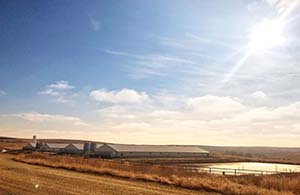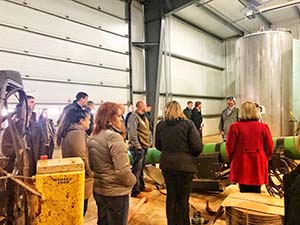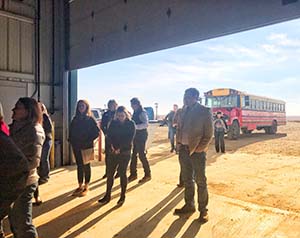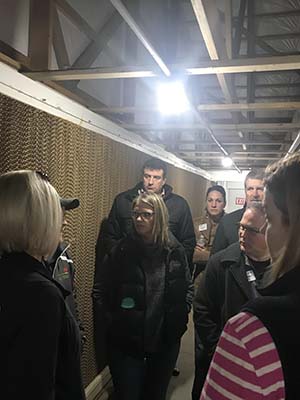Day One – Personal Development
Wednesday, December 4, 2019
Submitted by Stewart Cauble, Liberal
Introduction to Norton was given by Mike Posson (Norton City/County Economic Development) Mike Norton Grew up in Kansas was working in Canada in the oil and gas industry and moved back home to take care of his parents and family farm. Mike is most proud of the Honor Hunts which enable disable Veterans to take part in different types of hunts and encourages everyone to expand their leadership skills giving you more tools in your toolbox.
Cathy McClain Dauntless Leaders Cathy visited us once again after the Genesis Seminar.
Leaders can work with others on the other side of the spectrum. We broke down into groups and had discussions.
Betsy Wearing from Dane G Hansen Foundation
The foundation started 1965 and serves 26 Counties in NW Kansas
Friend of Dwight D Eisenhower.
Current Projects:
Focusses on What wants people to come home, bringing them home and keeping them home.
Brings questions:
NW KS Economic Innovation:
Bill Riley (Boards Manship) Presented us with a compendium on nonprofit board participation
Day Two – Personal Development
Thursday, December 5, 2019
Submitted by Justin Kastner, Manhattan
KARL Class XV session: Professional Development (Norton, Kansas)
Susan Sankey alerted the KARL class to an online resource: the Kansas Association of Community Foundations website (to be posted in the Facebook group), which details the transfer-of- wealth potential for each county in Kansas, and the relevance/importance of such campaigns as “Keep 5 in Kansas.”
Susan also reiterated the importance of completing post-seminar evaluations, which are used for improvement. She then facilitated an activity to help the KARL executive team prepare for the Topeka and Washington, D.C. sessions. She divided the class into four groups to brainstorm and discuss “issues” that we ought to focus on when our KARL class meets with public officials. Four groups then worked through the following:
KEY ISSUES: Key issues prioritized (each group arrive at top 3)
The groups worked for approximately one-half hour, and then at 8:46 am, spokespersons reported their top-three prioritized issues (summarized in the following table):
| Yellow group | Green group | Red group | Blue group |
| Healthcare | Childcare/education | Connectivity | Consolidation (of government services) |
| Rural depopulation (education funding, water, broadband, etc.) | Connectivity/ communication | Healthcare | Rural housing |
| Civil discourse | Trade policy (commodities, markets, and transportation) | Rural prosperity (economic development) | Healthcare policy and accessibility |
Susan also solicited feedback from class members regarding whether we would each like to meet with our delegation/representatives or others in Topeka and DC; class members can individually confer with Susan and Jill about this.
Debra T. noted that it would be good, appropriate, and timely in Topeka to hear a briefing on the state’s strategic plan for economic development; it was suggested that such a briefing might include a meeting with the consultants assisting with the plan.
Jill instructed class members to individually reach out and make our own appointments with our state delegations/representatives/senators for Topeka-based meetings on Thursday, January 16th (10:30 am – 1:00 pm); appointments may be made either legislative officials or other relevant officials, lobbyists, etc. That day will feature a “lunch on your own,” and class members can schedule individual or group meetings during the 10:30-1:00 timeframe; after 1 pm that day, we will all reconvene for everyone to share what they learned in their meetings. Note: When KARL class members reach out to legislative or other government-affiliated personnel, we can introduce our entire (professional and personal) interests, including that we are in the KARL program.
Julia Nelson (Risk Management/HR, Nelson Ag Companies) related to “Culture and Onboarding,” with Terry Nelson, Janet Sell, and Anita assisting. Terry opened up with a question/poll:
“Envision yourself 10 years from now…how many employees will your company have?” For the sake of the activity, Terry explained that the more employees you have, the more you will (for the sake of the activity) get paid (because risk equals reward). A quick poll was taken, and the class voted on their preferred number of employees: 15 votes for 10 employees, 3 votes for 100 employees, 4 votes for 1,000 employees, and 4 votes for 10,000 employees.
Terry explained that in his firm, “If you are in charge of somebody, you get leadership training every month.”
Julia began her remarks by referring to a binder containing several handouts; she first introduced the concepts of “Onboarding” and “Culture.” She reviewed the seven values of the Nelson Ag Entities Company Culture. Julia then talked about onboarding (what is it and why do we do it?), emphasizing that “organizations with a strong onboarding process improve new hire retention by 82% and productivity by over 70%.” She also reminded the group of a truism: “People join companies, but they leave managers.” Julia then walked the group through Nelson Ag’s Onboarding Plan and New Hire Paperwork (two distinct features in the binder of handouts).
Jackie M. asked a question about “what things does Nelson Ag do to get people to understand the value of the leadership training?” Julia answered with an emphasis on the ‘why,’ and one success story of how she won over a skeptic.
Terry chimed in with a reference to Nelson’s use of “performance coaches.” To understand what a “performance coach” is, Terry encouraged the group to watch Billions, Season 1, Episode 11.
Anthony S. asked a question about “why Nelson Ag invested in a leadership program,” and Terry answered by pointing to the importance of getting buy-in (and guarding against dissension) amongst the ‘key team at the top’ of the organization. Terry briefly responded, and then another response was offered by John Worden (COO, McPherson Hospital), who said it was important to have not only task- based work, but a true leadership culture.
Beth W. asked, “Who are your mentors/resources for developing this leadership program?” Terry pointed to some “Crucial Conversations” and “Crucial Accountability” programs, which are week-long programs.
Terry said we are going to learn about a business leadership model (i.e., the Team Bus Model; see late- afternoon session below) after an interactive activity (to take place later).
“Authentic Leadership – Defining your leadership style.”
He opened by declaring, “I am not a sage on a stage,” and encouraged interactive discussion. True knowledge happens through interactions, and everyone can “teach others” through your expertise
John’s talk began with Part I – Strengths and Managing Oneself
With respect to the leadership skill of being self-aware, John asked the class members how we best do the following:
John noted the rise of the effectiveness of online videos for communicating and learning.
John then reviewed the value of such assessment tools as Myers-Briggs, True Colors, KAI (featuring an adaptive-innovative continuum), and Strengths Finder, all of which are personality tests that help us to become more self-aware. He noted that we can use these insights to build teams with complementary strengths. John, with input from the KARL class, also pointed to a few other ways to assess strengths:
John then walked through a series of slides highlighting key skills needed if you want to lead: bring your passion, cultivate your reputation, display a seriousness of purpose and professionalism and have a sense of humor, responsibility, continue to grow, and take care of your team.
To close out Part 1, John emphasized the importance of both IQ (intelligence quotient) and EQ (emotional quotient, a measure of one’s emotional intelligence).
Leadership Styles and Results
John stressed that you want to avoid certain leadership styles—the “pacesetter,” “coercive.” More positively, he then highlighted some good, valid styles—the “role model,” “democratic,” “coaching,” and “affiliative”
Core Values
During this segment, John encouraged the class members to clarify their ethical/moral values. To extend this segment, at 11:07 am John divided the class into five groups for a group exercise, related to our “hidden talents,” and “core values.” After the groups met, there was a report-out, and each class member shared one talent and one core value.
The following hidden talents were reported out: writing (grants), photography (of rural scenes), strategizing to build funding for nonprofits, listening, cautiousness, driving combines, treating others the best I can, hospitality, helping and serving others, working with and sorting cattle, off-road truck racing, shearing sheep, waterskiing and surfing, cooking (for hospitality), polka dancing, staying calm/steady and listening to others to settle-down situations, negotiating, coaching (basketball), being a generous friend, being a good bridesmaid, collecting information, figuring things out (making things work) with optimism and persistence, sitting and observing and inventorying and connecting with others, karaoking/reading teleprompters, fishing and finance, making pies, plumbing and electrical work, documenting one’s reading with software programs, making emergency decisions quickly, snail mail (making cards, writing handwritten notes, and mailing them), and finding people’s emotional cues and honing in on them (finding what makes people ‘tick’).
The following core values were mentioned: altruistic, security/family/tradition, dependability, commerce, altruism and care for others above self, recognizing others’ dignity, honesty and integrity, team-work, security/tradition/power, power/commerce/tradition, growth/improvement, being just and fair in the treatment of people, the ability-to-sleep-at-night (peace of mind), power, aesthetics, honesty/ loyalty, helping people, honesty, science/logical, truism, science, honesty and dependability, science/altruistic/aesthetics (with ethics at the core), and commitment.
In closing, John noted that the following traits require no talent:
John also pointed to a “Top ten” multi-folded card, tucked inside the handout binders, and encouraged everyone as homework to write down their top ten core values.
Lee Ann Shearer provided at 1 pm an overview and tour of the They Also Ran gallery honoring losers of U.S. presidential races.
“Creating High Reliability Teams.”
In his remarks, John described a “Safe and Reliable Culture Maturity Model” that includes the following progressive stages:
John emphasized that both INTENTIONALITY and TIME are needed to move culture to the generative stage.
Terry assumed the mic, and launched a session related to “Common Workplace Behaviors and How to Manage.” In his session, Terry referred to a ‘cheat sheet’ in the binder of handouts (under the ‘workplace behaviors’ tab) with the following workplace behaviors: Passive, Assertive, Aggressive, and Passive-Aggressive. The class participated in a discussion about the characteristics of each of these four workplace behaviors.
Amongst other insights shared, Terry remarked that a huge task for a leader is discerning whether people who are passive are exhibiting passive behavior or passive-aggressive behavior. This requires discernment.
John noted that “aggressive” behavior is oftentimes a signal that the behaver has made their work about themselves (“it’s personal”) instead of the organization.
Terry, John, and Carolyn Harms (formerly of Spirit AeroSystems, presently, KARL Board of Directors) facilitated a lively interactive discussion with the class members on how to manage personnel exhibiting aggressive and passive-aggressive behavior.
Terry noted that because of passive-aggressive’s “victim” role being dominant in society, it is likely that approximately 50% of people work in the passive-aggressive mode.
The preferred behavior of aggressive (in contrast to the non-preferred trait of passive-aggressive) is characterized a person executing and being accountable; John and Terry emphasized, “If you are accountable 100% of the time, there is no way you are being passive-aggressive.” This is because passive-aggressive behavior oftentimes features making excuses or not admitting failures (not being accountable).
John then divided the class into four groups, with each group doing the following:
At 3:25 pm, the groups returned to act out skits demonstrating examples of workplace-based passive-aggressive. They were insightful, theatrical, and hilarious! Terry and John facilitated a post-skit debrief/ discussion for each skit.
At 4:00 pm, Terry launched into a final session entitled “Who is on your bus?”
The session was focused on the business leadership model of the Team Bus (detailed in the binder of handouts, under the “Your Bus” tab), with (usually) a driver and five riders.
The driver (or coach or supervisor) does three things:
The rider (direct report) does two things:
To get to 10,000 employees, with every supervisor having 5 direct reports, six (6) ‘hierarchical’ levels would be needed.
Supervisors give hands (tools), head (attitude), and heart (“I care about you”) to their direct reports.
Terry shared how the Team Bus Model has been tremendously useful as a management tool at Nelson Ag.
He emphasized that coaches/drivers/supervisors should have no more than 5 direct reports. So, keep it at 5 (or, if you can, 4) direct reports.
Terry talked about Jack Welch (formerly, CEO of GE) coming to the conclusion of the exceptionally important HR office (where any employee could go), and the critical value offered by HR performance coaches (see Billions reference above).
Janet and Terry talked about using Excel forms to collect feedback data; feedback should also be provided in writing. Terry advocated that feedback be provided once/week (not just once/month).
Supervisors, Terry emphasized, should be available 24-7 (all the time).
Amongst several topics discussed, Terry and the group talked about riders being loaned to different drivers (inter-departmental transfers) and the challenges and opportunities therein.
You can have assistant managers (assistant drivers) in the model, too.
To complete the session, the binder’s handout “Cardinal Rules for Leaders” were read out and briefly explained by Terry. These helpful rules include, amongst others, “praise in public but coach in private,” “don’t ask someone to do a task without providing the proper training and tools,” “inspect and coach regularly,” and “80% of your time should be spent coaching your team” (but can include working alongside your team).
After a wonderful meal sponsored by Nelson Ag Companies at the home of Terry Nelson (25998 Highway 383, Almena, Kansas), Clarke and Julia Nelson provided a lessons-learned recap of the Husky Hogs fire that occurred in June 2017. Highlights of their presentation included the following:
Day Three – Personal Development
Friday, December 6, 2019
Submitted by Darci Cain, Hays
KARL Class XV session: Professional Development (Norton, Kansas)
KARL class XV began their final Friday in Norton by reviewing the resonating take-always from the previous sessions. Many in the class discussed how the Nelson family dynamics made an impression. Most notably was the quick rebuild, fire story and impressive pace at which the rebuild occurred, along with the crisis management protocol implemented as their organization continues to learn and improve. Several in the class also mentioned the discovery of hidden talents and how effective it was in relating more personally to each other. Such a simple exercise created a connection that will be valued. A few mentioned the exploration of various leadership styles and applying the personality traits personally and professionally.
The previous day also came with many quotes such as “reputation – a lifetime to build but it only takes moments to burn”, “let your integrity speak for itself”, and “put the right people on the bus”. A highlight was the discovery of the singing snowman in the restroom where our discussion was located on the Nelson farm.
After the debrief our class loaded a bus and enjoyed an extensive tour given by Terry, Clark, and Julia. The integration of the Nelson company and its ability to manage employees in several industries within agriculture such as farming, swine, beef, application services, and other areas was of benefit for our class to observe throughout the morning. We are grateful for the opportunity to ask questions, learn and engage with the Nelson family for the day.





